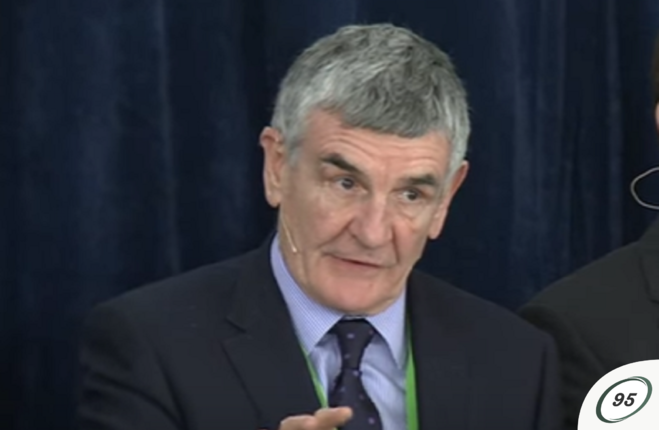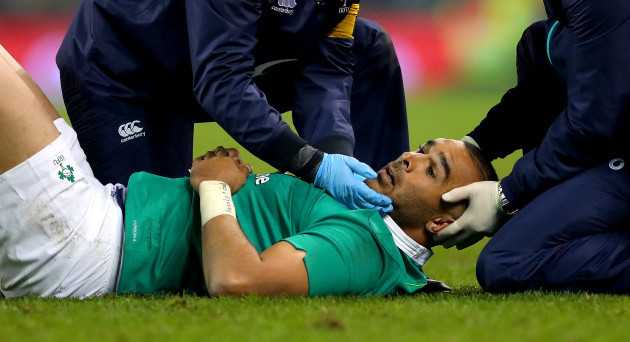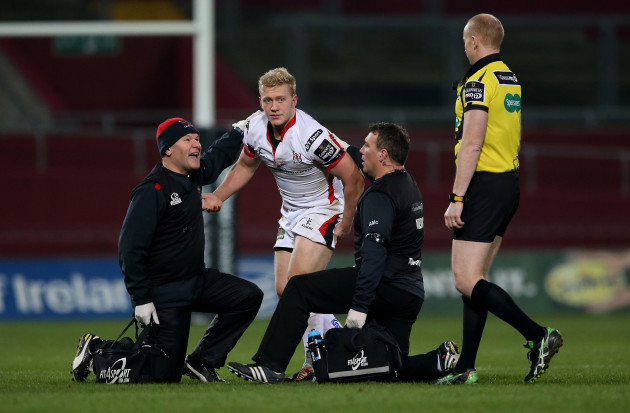INCIDENTS OF CONCUSSION have become the scourge of modern-day rugby.
It dominates the discourse around the sport and is the main cause of a disconnect with many parents, who no longer see rugby as a safe choice of sport for their children.
In recent weeks, commentators pored over the details surrounding suspected episodes of concussion, concerning our own Irish players.
The length of a head injury assessment (HIA) conducted on Leinster’s Johnny Sexton during their clash with Montpellier, caused much deliberation.
It was later confirmed that the out-half had suffered a neck injury, which accounts for why the HIA took between four and six minutes, rather than the stipulated 10-minute protocol as instructed by World Rugby.
Elsewhere, Munster’s Conor Murray became the subject of concern following the province’s Champions Cup meeting with Glasgow earlier this month.
Doubts were raised over whether Murray should have finished that game after he was withdrawn from the pitch for a HIA following two serious body blows, for which he received an on-pitch examination for the first hit.
Dr Barry O’Driscoll, a former medical advisor to the International Rugby Board (IRB), experienced a different brand of rugby. During his time as a player in the amateur era, concussion rates were lower, but not for the reasons you might expect.
“One of the reasons of course is that, concussion — nobody knew anything, or very little about concussion,” he told The42.
“The potential catastrophic, and potential medium and long-term complications of concussion — nothing was known about (them).”
For one, it tended to get brushed off and not even reported. Secondly, there was a stigma about concussion that with players, it could be a sign of weakness, letting their teammates down.
“There would be a tendency not to declare it or make very little of an issue out of it. So it’s for those reasons, plus the fact that the game was less physical, that it meant that the concussion rates were significantly lower then.”
Even among medical practitioners, they were still developing an understanding of concussion in those days.
Dr O’Driscoll recalls how concussion was perceived during his days of studying medicine.
“Just simply, that it was a functional disturbance of the brain. It wasn’t considered that there was any injury to the brain, it was just functional and you would get dizzy whilst the brain was just sorting a few things out.
There would have been a protocol (for dealing with concussion) depending on the symptoms. If it was very minor symptoms, you just carried on playing, if it was a little bit more severe you’d come off. There would have been no proactive approach, you just waited until the symptoms settled and you started playing again.”
“Obviously now, it’s relatively much more sophisticated compared to then. Having said that, we still know very little about concussion. We know now that after symptoms stop, the brain may not be functioning really well.
“This is expressed time and time again in research.”
After graduating, Dr O’Driscoll spent most of the next decade playing rugby before getting appointed onto the medical committee for the IRFU as well as a medical advisor to the IRB.
By the early 2000s, concussion was becoming a worrying issue in sport and in 2004, Dr O’Driscoll travelled to Zurich as the IRB’s representative, to attend a conference dealing with concussion in sport.
A consensus was reached to introduce a new protocol whereby any player who was concussed had to go off the field and stayed out for three weeks, unless a neurologist approved they could go back and play earlier.
Based on that consensus, it was altered slightly in rugby to allow a player with signs or symptoms of concussion to undergo a six-day graded return-to-play process.
Under that protocol, the player had to be symptom-free during each of those days with training levels increasing slightly everyday.
If they showed any symptoms, they were ordered to go back to the previous day and if that happened more than twice, they had to see a neurologist.
Dr O’Driscoll was happy to implement that regulation in rugby.
“I thought, considering our knowledge and the depth of our lack of knowledge (of concussion), that was a reasonable conclusion to come to, to protect the players.
Rugby’s a game and we all know going into it that no players are protected completely at any time. But, you weigh up the risks and that consensus group was accepted as the leader in sports because it had representatives from every medical specialty in neurosurgery, radiology, pharmacology and all the major sports where concussion was a factor were represented on it.
“And it was taken as a very fair consensus. We saw no reason in rugby to go outside of that.”
O’Driscoll returned to the conference four years later, but when a new directive relating to concussion treatment in rugby was introduced in 2012, O’Driscoll resigned.
“World Rugby, really out of the blue, brought in a new system for the professional player — not for the amateur player, community player or schoolboy player, that was still as per the consensus in Zurich,” he says.
“They decided, that with the professional player, they would, if he showed signs or symptoms of concussion out on the field, take him off and give him a five-minute assessment.
“And if he passed this, he could go back on and play. Not only that, they actually introduced it as an experiment in the world U20 tournament. In other words, they introduced it for the very first time with teenagers.
“That’s where I said I couldn’t accept that at all and that’s why I resigned.”
(World Rugby maintain that the HIA protocols are not contrary to the position agreed in Zurich. “The HIA is based on the SCAT 3, an outcome of Zurich/Berlin, and the Graduated Return To Play protocol was also born from the same forum and was overseen by an independent concussion advisory group,” a spokesperson told The42.)
Support for his convictions were hard to come by on the medical front, but within the rugby community, O’Driscoll was applauded by many of his peers.
“Outside of that (medical) committee, I had a huge amount of support from within the game, from people I respect and people I played with. I’ve continued to really get a lot of support from people whose support is very worthwhile.”
The length of time for the pitch-side concussion assessment was extended from five to 10 minutes in 2014.
O’Driscoll still maintains however, that concussion cannot be confirmed inside such a short timeframe.
“Five, 10, 15 (minutes), you can’t rule out concussion. That’s what it’s claiming to do. You cannot rule out concussion in that time but they’re trying to say they’re doing this test on somebody who’s showing no sign and no suspicion and no symptom.
“Articles have been written saying, ‘No we can’t confirm or rule out concussion on the field.’ And they can’t do it in 10-15 minutes. The thing that might happen as far as pitch-side (treatment) goes, there is a lot of research going on and there may well come a blood test that can show if the brain is damaged or not. We’re a few years off that.”
(“We do not take players with suspected concussion off for a HIA,” a World Rugby spokesperson told The42. “Any player displaying clear symptoms or suspected signs, from a checklist of 11 recommended by Zurich, are immediately and permanently removed from the field. There is no HIA tool.”)
Despite his protestations against the current rulings about how to treat concussion in rugby, O’Driscoll still enjoys the sport.
He comes from a family steeped in rugby — you may have heard of one relative in particular — and believes the advantages gained through playing it, outweigh the negatives.
And it’s through his association with the sport that he has developed a passion for ensuring that the correct measures are taken to protect players.
“I played it all through to international rugby, my brother played international rugby. Brian O’Driscoll is my second cousin and his father played for Ireland with me. It goes right through the family.
“I went to rugby schools and it was very much part of my life, so I do love the game and having had that, I’m very aware and concerned, that we should look after the welfare of the players in every way we can.
“No matter how much we look after them, it’s a physical game and a traumatic game, they’re going to get injuries that we can’t do anything about. But we have to treat them properly.
“These are injuries to the most valuable part of all — the brain. They’re not treating it properly and it has since become a much more traumatic game. The brain is even more important as far as protecting it goes.”
His resolution to the problem is a simple one, and reverts back to the system that predates the pitch-side assessment era, whereby if a player displays ‘any sign, any symptom, any suspicion, you come off and you stay off.’
“That’s what applies to every other sport. It applies to 99% of the rugby community as well. What is the difference between their brains and the brains of the elite player? Why should the elite player be exposed to this?”
– Updated 12.35, 4 Feb: This article was updated to include responses from a World Rugby spokesperson.
Subscribe to The42 Rugby Show podcast here:
****
The42 is on Instagram! Tap the button below on your phone to follow us!






